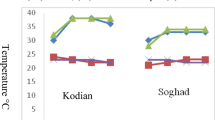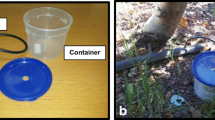Abstract
Specific apple replant disease (SARD) is a problem in replanted apple orchards worldwide. The causative agents in New Zealand are thought to be biotic in nature. The effect of commercial Trichoderma bio-inoculants on SARD symptoms was investigated in two independent experiments in two SARD soils and one non-SARD soil treated with chloropicrin, commercial Trichoderma pellet and powder formulations, and a nitrogen, phosphorus and potassium (NPK) supplement. Rooted stool-bed cuttings of ungrafted ‘M.26’ apple rootstocks grown in the SARD soils treated with chloropicrin fumigation produced significantly more biomass over the growing season with reduced root disease symptoms compared with untreated controls. The plants grown in the SARD soils treated with the Trichoderma pellet formulations or the NPK supplement also exhibited a significant improvement in growth, with no reduction in root disease symptoms. Similar responses were noted when dead (autoclaved) Trichoderma pellet formulations or unformulated pellets were applied. No disease reduction or growth improvement was observed in the plants grown in soil treated with a Trichoderma spore powder (without the standard carrier included in the pellet formulations). Thus, the improved growth response associated with the Trichoderma treatments correlated with an additive associated with the pellet formulation, and not to the presence of ‘live’ Trichoderma inoculum.
Similar content being viewed by others
References
Braun PG (1995) Effects of Cylindrocarpon and Pythium species on apple seedlings and potential role in apple replant disease. Canadian Journal of Plant Pathology 17, 336–341.
Bunt JA, Mulder D (1973) The possible role of bacteria in relation to the apple replant disease. Mededelingen van de Faculteit Landbouwwetenschappen. Rijksuniversiteit Gent. 38, 1381–1385.
Catska V, Hudska G (1993) Use of Agrobacterium radiobacter for biological control of apple replant disease. Acta Horticulturae 324, 67–72.
Catska V, Taube-Baab H (1994) Biological control of replant problems. Acta Horticulturae 363, 115–120.
Granatstein D, Mazzola M (2001) Alternatives to fumigation for control of apple replant disease in Washington State orchards. Integrated Fruit Production IOBC/wprs Bulletin 24, 265–271.
Gu Y-H, Mazzola M (2003) Modification of fluorescent pseudomonad community and control of apple replant disease induced in a wheat cultivar-specific manner. Applied Soil Ecology 24, 57–72. doi:10.1016/ S0929-1393(03)00066-0
Horner IJ (2008) ‘Beyond methyl bromide soil fumigation: a guide for New Zealand strawberry growers.’ Manual produced for Strawberry Growers NZ Inc. (The Horticulture and Food Research Institute of New Zealand Ltd: Auckland)
Horner IJ, Tustin DS, Bigwood EH (2006) Timing of apple root disease and plant growth responses in replant soil. In ‘Proceedings of the fourth Australasian soilborne disease symposium, Queenstown, New Zealand, 3-6 September 2006’. (Eds RE Falloon, MG Cromey, A Stewart, EE Jones) pp. 11-12.
Horner IJ, Tustin DS, Kandula DRW, Jones EE, Bigwood EH, Breen KC, Dayatilake GA, Scheper R, Stewart A (2005) Specific apple replant disease: causes and remediation. ‘HortResearch Client Report No. 15714’. (The Horticulture and Food Research Institute of New Zealand Ltd: Auckland) p. 25.
Jones EE, Mead A, Whipps JM (2003) Evaluation of different Coniothyrium minitans inoculum sources and application rates on apothecial production and infection of Sclerotinia sclerotiorum sclerotia. Soil Biology & Biochemistry 35, 409–419. doi:10.1016/S0038-0717(02)00292-4
Mai WF, Abawi GS (1981) Controlling replant diseases of pome and stone fruits in northeastern United States by preplant fumigation. Plant Disease 65, 859–864.
Manici LM, Ciavatta C, Kelderer M, Erschbaumer G (2003) Replant problems in South Tyrol: role of fungal pathogens and microbial population in conventional and organic apple orchards. Plant and Soil 256, 315–324. doi:10.1023/A:1026103001592
Mazzola M (1997) Identification and pathogenicity of Rhizoctonia spp. isolated from apple roots and orchard soils. Phytopathology 87, 582–587. doi:10.1094/PHYTO.1997.87.6.582
Mazzola M (1998) Elucidation of the microbial complex having a causal role in the development of apple replant disease in Washington. Phytopathology 88, 930–938. doi:10.1094/PHYTO.1998.88.9.930
Mazzola M (1999) Transformation of soil microbial community structure and Rhizoctonia-suppressive potential in response to apple roots. Phytopathology 89, 920–927. doi:10.1094/PHYTO.1999.89.10.920
McLean KL, Swaminathan J, Frampton CM, Hunt JS, Ridgway HJ, Stewart A (2005) Effect of formulation on the rhizosphere competence and biocontrol ability of Trichoderma atroviride C52. Plant Pathology 54, 212–218. doi:10.1111/j.1365-3059.2005.01158.x
Ozbay N, Newman SE (2004) Biological control with Trichoderma spp. with emphasis on T. harzianum. Pakistan Journal of Biological Sciences 7, 478–484. doi:10.3923/pjbs.2004.478.484
Rom CR (2004) Interaction of pre-plant treatments, fertiliser application time and method, and cultivar on performance of apples in a replant site. Acta Horticulturae 635, 31–40.
Slykhuis JT, Li TSC (1985) Responses of apple seedlings to biocides and phosphate fertilisers in orchards soils in British Columbia. Canadian Journal of Plant Pathology 7, 294–301.
Szabo K, Winkler H, Petzold H, Marwitz R (1998) Evidence for the pathogenicity of actinomycetes in rootlets of apple seedlings from soils conducive to specific apple replant disease. Acta Horticulturae 477, 55–58.
Tang W, Yang H, Ryder M (2001) Research and application of Trichoderma spp. in biological control of plant pathogens. In ‘Bio-exploitation of filamentous fungi’. (Eds SB Pointing, KD Hyde) pp. 403–435. (Fungal Diversity Press: Hong Kong)
Tustin DS, Horner IJ, Breen K, Dayatilake D, Bigwood E (2008) Growth responses of young apple replants induced by soil remediation treatments for specific apple replant disease. Acta Horticulturae 772, 407–411.
Utkhede RS, Smith EM (1992) Promotion of apple tree growth and fruit production by the EBW-4 strain of Bacillus subtilis in apple replant disease soil. Canadian Journal of Microbiology 38, 1270–1273.
Utkhede RS, Smith EM (1994a) Biotic and abiotic causes of replant problems in fruit trees. Acta Horticulturae 363, 25–32.
Utkhede RS, Smith EM (1994b) Development of biological control of apple replant disease. Acta Horticulturae 363, 129–134.
Utkhede RS, Smith EM (2000) Impact of chemical, biological and cultural treatments on the growth and yield of apple in replant-disease soil. Australasian Plant Pathology 29, 129–136. doi:10.1071/AP00021
Westcott SW III, Beer SV, Israel HW (1987) Interactions between actinomycete-like organisms and young apple roots grown in soil conducive to apple replant disease. Phytopathology 77, 1071–1077. doi:10.1094/Phyto-77-1071
Author information
Authors and Affiliations
Corresponding author
Rights and permissions
About this article
Cite this article
Kandula, D.R.W., Jones, E.E., Horner, I.J. et al. The effect of Trichoderma bio-inoculants on specific apple replant disease (SARD) symptoms in apple rootstocks in New Zealand. Australasian Plant Pathol. 39, 312–318 (2010). https://doi.org/10.1071/AP09096
Received:
Accepted:
Issue Date:
DOI: https://doi.org/10.1071/AP09096




